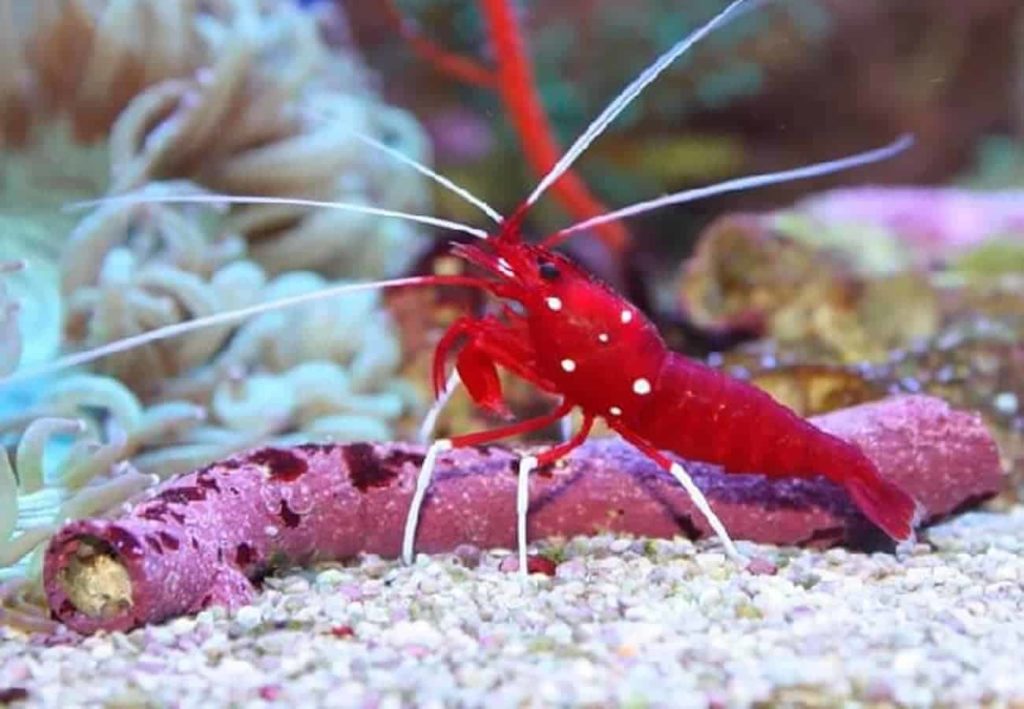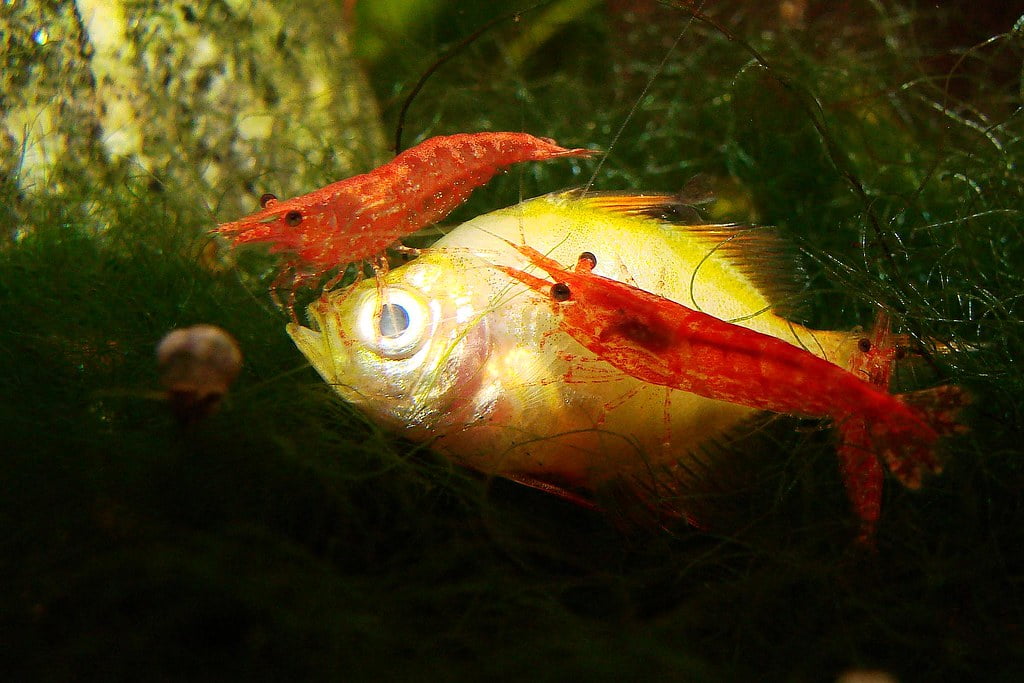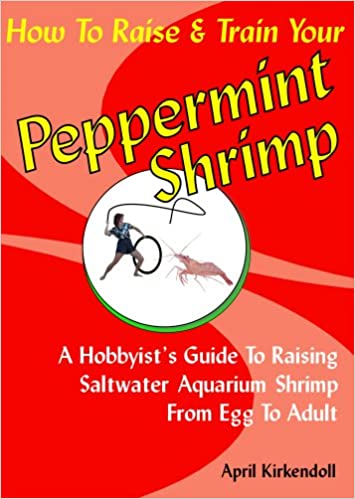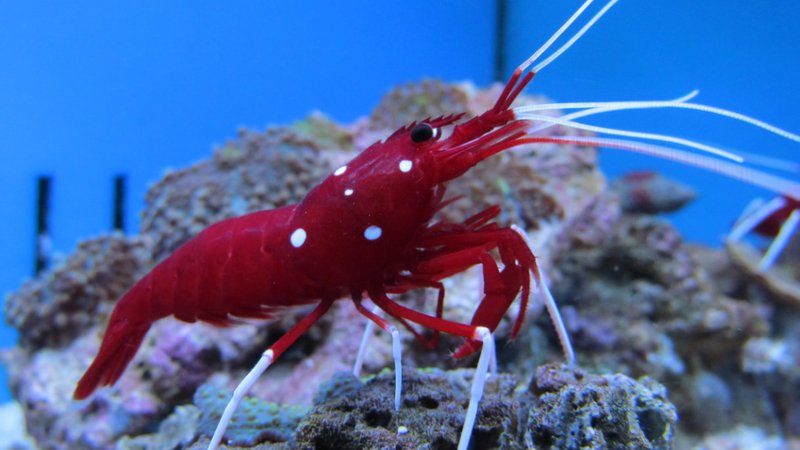The blood shrimp, also known as the blood-red shrimp or blood worm shrimp are a relatively new addition to the saltwater aquarium hobby. They have been introduced with an intent to control algae growth in marine aquaria and provide a food source for larger predatory fish.
In this article, we will go over 6 essential things you need to get before getting blood shrimp care started.
See also:
- Is Keeping Cleaner Shrimp And Fire Shrimp Together Good?
- Camel Shrimp Vs Peppermint Shrimp: 7 Amazing Differences
- How Many Peppermint Shrimp Per Gallon? – Care Guide
Facts About Blood Shrimp
Habitat and appearance
The blood shrimp genus Lysmata is among the most popular saltwater shrimp in the hobby. The shrimp are usually brilliantly colored, medium-sized, and fairly hardy, and can be found in tropical regions all over the world.
Their appearance in an aquarium really stands out. They look a lot different from fish. The combination of this and their unique behaviors make them an attractive addition to any aquarium.
One reason for their popularity is that Blood Shrimps are among the brightest and most beautiful saltwater species.
The carapace of this creature is predominantly red, with small white spots scattered across its surface. Part of their red spreads along their legs and antennae.
There will be times when they look pale. Stress or illness may cause their color to fade, but it will return once they are well again.
Likewise, they’ll be paler after molting but can expect their exoskeleton to darken as it hardens.
Their bodies are 1.5-2 inches long, but their antennae, which can be as long as their bodies, could take up more space. This antenna is used to “taste” and feel the environment.
Similarly, these crustaceans have ten legs on the end of their body.
Located behind the carapace lies the abdomen, which is composed of six segments. As a result of their many segments, they are able to curl up. The sixth segment is attached to a small, fan-shaped tail.
A pair of swimming appendages known as pleopods are present on the first five segments. Their shape is similar to a paddle, which is meant to help them navigate through the water.
The blood shrimp is a hermaphrodite, containing both male and female reproductive organs. Therefore, any two individuals may mate together. In other words, it is unnecessary to sex them.
In general, the body shape of this species is typical of shrimps. The red color of their skin attracts people to them and tempts them to purchase one for their aquarium.
The blood shrimp is considered a cleaner shrimp
The Blood Red Fire Shrimp is also considered to be a cleaner shrimp species, just like those species of the Scarlet Skunk shrimp, the Coral Banded shrimp, and the Peppermint shrimp. In addition to setting up a clean station in your tank, the shrimp will clean your fish as part of their territory by picking off dead scales and skin and removing parasites.

Compatibility
There is absolutely no compatibility between blood-red fire shrimp and hawkfish or marine bettas. In my experience, adding cleaner shrimp to tanks with large enough fish can be a good idea because I have even witnessed a fairly large cardinal fish swallow one whole within seconds of adding it to the tank.
Moreover, if you intend to add fire shrimp to your reef tank, be aware that they may also pick at your corals.
6 Things About Blood Shrimp Care
Ideal habitat
These shrimp will thrive in all sizes of tanks, both small and large-they adapt well to nano aquariums and large reef setups alike. It is important to fully cycle your tank before introducing fire shrimp, since they are sensitive to nitrites and ammonia, and you should know how to manage a saltwater aquarium and keep nitrate levels down. When you use copper-based medicine on your fish, remove the shrimps to avoid poisoning them. Not only parasitic invertebrates but also your blood shrimp will be killed by copper, so don’t use it.
Occasionally, blood shrimp will be shy and sensitive to bright light. A live rock structure that is hidden from the light will make them more comfortable.
Aquarium size and layout
Fire Shrimp appear to be a little bipolar, behavior-wise. They are, moreover, quite shy and retiring. It is much more likely for them to become active under low-light conditions. If, however, the tank is brightly lit, they will tend to stick to the shadows and avoid direct light. It is even possible that they may become totally nocturnal, only going out to feed at night or when the moon is up.
Most likely you’ll see them under poor lighting, around other fish in their tanks, or when there is not a lot of food to scrounge up at night. It will be more likely for them to feed and be out in the open during the day if they don’t have much to scavenge at night. Last but not least, Individual Fire Shrimp certainly have their own personalities, so it’s best to provide a good mixture of hidden spots, shady spots, and open areas so you’ll know what your shrimp prefers.
Water conditions
A standard marine environment is ideal for Fire Shrimp. Since this species lives nearer to the equator in the wild, pH should be between 8.0 and 8.4 and temperature should remain stable between 75 and 82°F. The Fire Shrimp are not particularly concerned with currents but tend to crawl over rocks more than anything else, so do not overdo it.
As is true of all invertebrates, Fire Shrimp are more sensitive to dissolved nitrogenous waste than most fish. It is important to control ammonia, nitrite, and nitrate levels since levels from 20 to 40ppm are dangerous. However, as long as you have a fully mature and cycled tank, your parameters should remain low.
Although Fire Shrimps are some of the harder invertebrate species, they should never be the first additions to a new aquarium. Their population crash will be aggravated by the New Tank Syndrome, which will skyrocket ammonia levels.
You must use extreme caution when using medications on aquariums with invertebrates since all of them are very sensitive to them. Medications for fish are often directed at parasitic infections. It’s easy for a medication to kill Fire Shrimp accidentally since parasites are invertebrates.
Feeding and diet
In terms of nutritional or feeding requirements, the Fire Shrimp doesn’t have any specifics to note. They are cleaner shrimp species that consume parasites and dead skin from your fish. Added to this, they will scavenge and eat leftover food in the tank, including defrosted frozen foods and flakes. Especially, blood shrimp have been seen to eat food straight from aquarists’ hands.
It is likely to be okay if you have a sufficiently fed SPS tank (low bioload, low feeding) if your tank is ultra-clean. Otherwise, you may want to target feed your shrimp if your tank is not ultra-clean. Be sure that you monitor their eating and they aren’t bullied out of eating.

Tankmates
For community aquariums, blood shrimp are an excellent choice. Even though they lead a mostly solitary life, they are around many other animals in the wild.
In their role as cleaner shrimp, they interact with fish to remove parasites. There is a good chance that most fish won’t eat Blood Shrimps when they receive the cleaning service, but you just never know what a hungry fish will do. Therefore, pick your tankmates carefully to ensure their safety.
Aggression is usually not an issue because blood shrimps rarely attack fish, and most do not attack them at all.
However, large fish can be a concern. Blood Shrimp may be viewed as a snack if the animals are large enough to eat them. In your small aquarium, stick with smaller fish.
Blue Hippo Tangs are excellent tank mates because they are known to be particularly susceptible to parasites, so they can really benefit from being around cleaner shrimp.
Blood Shrimps can be kept alongside other invertebrates. Other cleaner shrimp are the only exceptions. To avoid fighting, keep one cleaner shrimp (including Blood Shrimp) per tank.
Although Blood Shrimps have been reported to cause damage to corals, they are generally thought to be reef safe.
Breeding
The Fire Shrimp is a species of shrimp bred in captivity. The shrimps are hermaphrodites, which means they possess both male and female reproductive organs, so whichever pair of shrimps you choose, you will have the genetic material necessary for the shrimp to reproduce. The above isn’t a guarantee that the two individuals you get will be compatible, but it does suggest that it won’t be too hard to find a good match for them. In comparison, you would need as many as five to seven saltwater fish to guarantee any male/female connection, so you would have to make the sacrifice as much as possible.
It is a bit of a challenge to successfully breed saltwater fish or a variety of invertebrates. If you are interested in learning more about breeding cleaner shrimp, I would recommend checking out two sources. One of the sources is called MOFIB. You can find some helpful forum topics about breeding this shrimp there.
A second excellent resource is the “How to Raise & Train Your Peppermint Shrimp” book. Despite being written about a different shrimp species, lots of the lessons in this book can be applied in many other situations.

Pros And Cons Of Keeping The Blood Shrimp
Keeping these shrimps, just as with any tank occupant, comes with its pros and cons.
Pros
- Keeping them in your aquarium has the advantage of removing harmful parasites and dead skin from your fish.
- Furthermore, they will help keep your aquarium clean by eating leftover food.
- There is no special diet or water requirement in order to keep these shrimp.
Cons
- The shrimp will nibble at corals in reef tanks, especially at night, when they can’t be seen.
- They often spend most of their time in their cave, so you probably won’t see them a lot of the time.
Video: Blood Red Fire Shrimp Care (Species Spotlight)
FAQs
What size aquarium do blood shrimp need?
Blood Shrimps grow to a maximum length of 2 inches, so they can fit into small aquariums. 10 gallons is the minimum size, but larger tanks allow them to explore more. If you can provide more space for them, they’ll be happier.
The larger tanks take up more space and are more expensive, but they are easier to maintain, particularly in terms of their water quality. By doing this, you can keep all inhabitants healthy.
Can you keep blood shrimps together?
No. The Blood Shrimp is peaceful toward fish and most other invertebrates, but they tend to attack their similar species and one another.
Despite the fact that this fight may not be fatal, you should remove any possibility that it could be. A Blood Shrimp should only be kept in a single aquarium.
Multiplying shrimp is only really a good idea when you have a very large tank so they can avoid each other most of the time.
Are blood shrimps suitable for your aquarium?
Saltwater shrimp are essential to a marine aquarium. It is very entertaining to watch their colors and behaviors.
Among the many species of shrimp, blood shrimp are a favorite. As soon as you see them, you’ll understand why. They are incredibly beautiful with their bright red bodies and white spots.
It’s okay to use them in a wide range of aquarium setups as long as there are no fish large enough to eat them. Other cleaner shrimp aren’t allowed to be eaten either.
These beautiful fish might be nocturnal, but they’ll still add a lot of beauty to your aquarium. It is easy and inexpensive to maintain too, so they’re a great choice for every tank.
Conclusion
Your saltwater aquarium will certainly glow with color when you add a Blood Red Fire Shrimp. Despite being a bit pricey and shy, they are absolutely worth having in your tank.
Has keeping Blood Red Fire Shrimps been a fulfilling experience for you? Are you taking care of the blood shrimp? Welcome to my blog post and I hope it is informative for you.

Annette M. Chaney is an experienced marine biologist with over 20 years of experience as an aquarist and fishkeeper. She started her first aquarium at a young age, filling it with frogs and goldfish obtained from the ten-cent pet store.
Annette grew up caring for and breeding African Cichlids, which led to a hobby in high school that doubled as a profitable means. Attending Reed College gave her time to solidify herself as an accomplished aquarium caretaker with an eye for sales. After that, from 2009 – 2013, she studied at Roger Williams University – one of the most prestigious universities for Aquaculture and Aquarium in USA. She is the founder of AquariumCircle since 2010.
